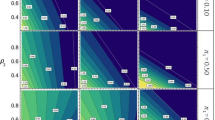Abstract
The power to detect QTL using near-isogenic line (NIL) comparisons versus recombinant inbred (RI) populations was assessed. The power to detect QTL was found to be generally greater when using RI populations than when using NIL contrasts. Power to detect QTL with NIL contrasts never exceeded that of RI populations when the number of RI lines is maximized relative to replication of lines for a given number of experimental units. The relative power of NIL contrasts is highest for traits with high heritability and when a gain in precision is realized due to increased replication of entries. Although NIL populations are generally less powerful than RI populations of similar size, some practical considerations may enhance the value of these materials. Availability of NILs allows the genetic effect of a specific chromosome region to be determined by comparing two lines; all RI lines in a population need to be rescored for each new trait even if the effect of a specific chromosome region is suspected. NIL comparisons may allow genetic differences to be detected by visual inspection; genetic effects can only be expressed as means and variances with recombinant inbred populations. In summary, RI populations generally, and in some cases, substantially, provide better power for QTL detection than NIL comparisons. Practical considerations, however, indicate that many factors need to be considered when choosing a population structure to meet an experimental objective.
Similar content being viewed by others
Author information
Authors and Affiliations
Additional information
Received: 12 December 1996 / Accepted: 21 March 1997
Rights and permissions
About this article
Cite this article
Kaeppler, S. Quantitative trait locus mapping using sets of near-isogenic lines: relative power comparisons and technical considerations. Theor Appl Genet 95, 384–392 (1997). https://doi.org/10.1007/s001220050574
Issue Date:
DOI: https://doi.org/10.1007/s001220050574




